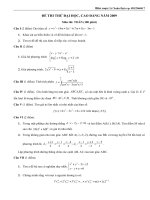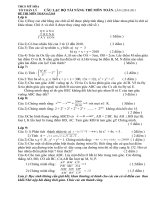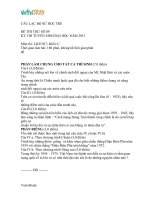Joint dislocation CLB Y Khoa Trẻ ĐH Y Khoa Vinh
Bạn đang xem bản rút gọn của tài liệu. Xem và tải ngay bản đầy đủ của tài liệu tại đây (6.03 MB, 84 trang )
Bs CKI.CTCH.Trần Văn Thuyên
Trưởng Khoa CTCH
Phone:0983969491
Mail:
Page Facebook:Bs Thuyên Chấn thương
chỉnh hình - cơ xương khớp bv Quốc tế
Vinh
INDICATIONS FOR OPEN
REDUCTION
1. If anatomical, concentric reduction cannot be achieved
by gentle, closed techniques with the patient under general
anesthesia. Interposed soft tissues or osteochondral
fragments may contribute to the irreducibility.
2. If a stable reduction cannot be maintained. Articular
fractures often are unstable and must be reduced and fixed
to ensure stability of the reduction.
3. If careful evaluation before closed reduction reveals
normal neurological function and, after reduction, a definite
complete motor and sensory nerve deficit becomes evident
4. If circulatory impairment distal to the injury is well
documented before reduction and persists after reduction.
Further assessment of the circulation is essential and should
include arteriography.
5. If ischemia is persistent. Surgical exploration with
appropriate management of the vascular injury is indicated.
Anatomy
.
Shoulder Dislocation
Anterior
Shoulder
Dislocation
Inferior (Luxatio
Erecta)
Rare
Arm locked overhead 110-160
deg abduction, hand resting on
head
AP radiograph: spine parallel to
humerus
Shoulder
Dislocation
Posterior
2-4% of shoulder dislocations
Arm held across chest
Adducted
Internally rotated
Flat and squared of
HIP
The hip joint is inherently stable, and hip
dislocations generally are produced by high
energy trauma
Posterior dislocations occur much more
frequently than anterior dislocations
posterior hip dislocation present with hip
flexion, adduction, internal rotation, and a
shortened extremity
Anterior dislocations cause the leg to be held in
a position of abduction and external rotation
The Pipkin classification of dislocations
with femoral head fractures
.
Reduction
Several methods of closed reduction have
been used successfully, all of which generally
consist of recreating the injurious deforming
force :
+ for posterior dislocations—flexion, adduction,
and internal rotation;
+ for anterior dislocations—abduction and
external rotation in extension).
Traction in line with the afected femur and
small amounts of rotation and abduction and
adduction complete the reduction
Allis maneuver
Stimson maneuver.
Sciatic nerve palsy complicates simple
posterior hip dislocation in 13% of patients.
No neurological sequelae have been
reported after anterior hip dislocation
ACROMIOCLAVICULAR
JOINT
Rockwood classification
Neither
acromioclavicular
nor coracoclavicular
ligaments are
disrupted
both ligaments are
disrupted.
acromioclavicular ligament
is
disrupted, and
coracoclavicular ligament
is intact
ligaments are
disrupted, and
distal end of clavicle is
displaced posteriorly
into or through trapezius muscle
Rockwood classification
ligaments and muscle
attachments are
disrupted, and clavicle and
acromion are widely separated
ligaments are disrupted, and distal
clavicle is dislocated infe-rior to
coracoid process and posterior to
biceps and coracobra-chialis tendons









